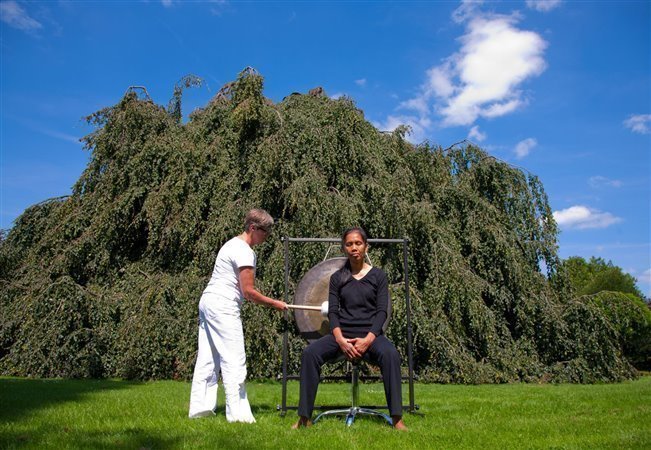How to Heal with the Power of Sound

We all know that sound can set a mood and have an effect on our feelings, but sound is far more powerful than it's often given credit for. Our bodies take cues from surrounding sounds and rhythms — knowing when to energize and when to slow down. The powerful effects of sound are being studied and put to practice more and more these days. Research shows that sound can help reduce stress, create a deeper sense of well-being, and even promote healing. In fact, many experts say that sound therapy is at the cutting edge of healing. But because this is still a relatively new concept in our modern-day culture, many of us wonder: what exactly is sound healing, how does it work, and how can it be used in our daily lives?
What is Sound Healing?
Although it's gaining mainstream popularity, the notion that sound affects the health of the mind and body isn't anything new. Sound has been used as a healing tool in various cultures for thousands of years. For instance, in Hindu culture, chanting and mantra recitation are ancient traditions that are used for spiritual healing.
So what does it mean to heal through sound? According to the law of physics, everything has an energetic frequency that naturally vibrates. Sometimes factors, such as stress or illness can cause our natural frequencies to get out of tune, so to speak. Sound healing works to return those vibrations to their natural states. Whether it's playing soothing music in a nursery or chanting in a yoga class, the intention of sound healing is always the same: to bring us from a place of imbalance to a place of balance.

How Does it Work?
Sound healing works by providing fluctuating (or out of tune) brainwaves with a stable frequency that the brainwaves can attune to. This application of rhythm and frequency makes it possible for our normal waking consciousness to shift down to a state of relaxed consciousness. From there, it is possible to reach a meditative state, and then eventually sleep, which is where internal healing can occur.
Stress hormones decrease under these conditions, which positively affects both the mind and body on many levels. Sound therapy can be used to help improve sleep disorders, anxiety, depression, PTSD, and pain. It has even been shown to help cancer patients recover more quickly from chemotherapy.

How to Use Sound Healing in Your Life
There are a handful of ways to use sound therapy for your own personal healing. The most popular techniques that are being used today are:
1) Singing Bowls & Bells
Whether made out of Tibetan metal or quartz crystal, singing bowls make a soothing ringing sound when a felt-tipped mallet is rubbed around the edge. Rhythms can also be produced by striking the edge of the bowls and bells. The vibrations and tones that are emitted can slow down breathing, brain waves, and heart rates. This produces a deep sense of calm and well-being.
2) Gong Bath
A gong bath is an ancient Asian sound healing technique in which the participant is surrounded by gongs that are struck. Gong baths feel like massages because they vibrate all of the water within the body, which produces an amazing sense of well-being.
3) Om Chanting
The sacred, familiar “aum” is known as the mother tone, which comprises the frequencies of all other sounds. Repetitive chanting of this tone is the first step to meditation. Research shows that chanting can stabilize heart rate, lower blood pressure, produce endorphins, help the mind focus, and alleviate stress levels.
4) Humming
This simple sound greatly affects our emotion. It can keep us healthy by reducing stress, enhancing sleep, and producing happy chemicals in the brain such as oxytocin. It can also improve airflow between the sinuses and the nasal cavity, which helps circulate oxygen throughout the body, and can protect the health of sinuses.
5) Classical and Soothing Music
Classical and soothing music can be used to enhance learning and creativity, for pregnancy and child development, and to help alleviate high blood pressure and muscle tension.
6) Kirtan
Kirtan is a form of music that narrates, recites, tells, and describes an idea of a story. In a kirtan practice, a leader sings the mantra and the audience sings it back. Through this exchange, the audience is able to connect with each other. Kirtan allows for meditation, free expression, giving and receiving, and safe vulnerability. These abilities lead to inner healing.
Our bodies, minds, and spirits always want to be in a state of balance, yet outer stimuli and noises can distract and prevent us from maintaining a state of harmony. Sound has the power to bring us to the source of the inner peace we all desire.


